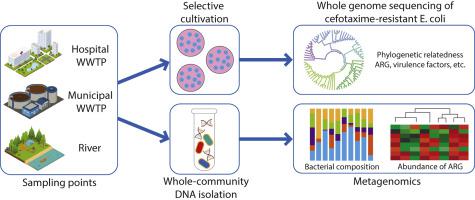Environmental Research ( IF 7.7 ) Pub Date : 2020-11-21 , DOI: 10.1016/j.envres.2020.110487 Iva Kutilova , Matej Medvecky , Pimlapas Leekitcharoenphon , Patrick Munk , Martina Masarikova , Lenka Davidova-Gerzova , Ivana Jamborova , Valeria Bortolaia , Sünje J. Pamp , Monika Dolejska

|
Wastewaters serve as important hot spots for antimicrobial resistance and monitoring can be used to analyse the abundance and diversity of antimicrobial resistance genes at the level of large bacterial and human populations. In this study, whole genome sequencing of beta-lactamase-producing Escherichia coli and metagenomic analysis of whole-community DNA were used to characterize the occurrence of antimicrobial resistance in hospital, municipal and river waters in the city of Brno (Czech Republic).
Cefotaxime-resistant E. coli were mainly extended-spectrum beta-lactamase (ESBL) producers (95.6%, n = 158), of which the majority carried blaCTX-M (98.7%; n = 151) and were detected in all water samples except the outflow from hospital wastewater treatment plant. A wide phylogenetic diversity was observed among the sequenced E. coli (n = 78) based on the detection of 40 sequence types and single nucleotide polymorphisms (average number 34,666 ± 15,710) between strains. The metagenomic analysis revealed a high occurrence of bacterial genera with potentially pathogenic members, including Pseudomonas, Escherichia, Klebsiella, Aeromonas, Enterobacter and Arcobacter (relative abundance >50%) in untreated hospital and municipal wastewaters and predominance of environmental bacteria in treated and river waters. Genes encoding resistance to aminoglycosides, beta-lactams, quinolones and macrolides were frequently detected, however blaCTX-M was not found in this dataset which may be affected by insufficient sequencing depth of the samples.
The study pointed out municipal treated wastewater as a possible source of multi-drug resistant E. coli and antimicrobial resistance genes for surface waters. Moreover, the combination of two different approaches provided a more holistic view on antimicrobial resistance in water environments. The culture-based approach facilitated insight into the dynamics of ESBL-producing E. coli and the metagenomics shows abundance and diversity of bacteria and antimicrobial resistance genes vary across water sites.
中文翻译:

捷克共和国市政和医院废水中产生广谱β-内酰胺酶的大肠杆菌及其抗药性:基于培养和宏基因组学的方法
废水是抗菌素耐药性的重要热点,监测可用于分析大量细菌和人群的抗菌素耐药基因的丰富度和多样性。在这项研究中,使用产生β-内酰胺酶的大肠杆菌进行全基因组测序,并对全社区DNA进行宏基因组分析,以表征在布尔诺市(捷克共和国)的医院,市政和河流水域中抗菌素耐药性的发生。
耐头孢噻肟的大肠杆菌主要是广谱β-内酰胺酶(ESBL)产生者(95.6%,n = 158),其中大多数携带bla CTX-M(98.7%; n = 151),并且在所有水中都被检测到除医院废水处理厂流出的样品外。根据检测到的40种序列类型和菌株之间的单核苷酸多态性(平均数34,666±15,710),在测序的大肠杆菌(n = 78)中观察到了广泛的系统发育多样性。宏基因组学分析显示,细菌属的发生率很高,具有潜在的致病成员,包括假单胞菌,大肠埃希菌,克雷伯菌,气单胞菌,肠杆菌和未经处理的医院和市政废水中的杆状杆菌(相对丰度> 50%),以及处理过的河水中的环境细菌占多数。经常检测到编码对氨基糖苷类,β-内酰胺类,喹诺酮类和大环内酯类抗药性的基因,但是在该数据集中未找到bla CTX-M,这可能受样品测序深度不足的影响。
研究指出,市政处理的废水可能是对地表水具有多重耐药性的大肠杆菌和耐药性基因的来源。此外,两种不同方法的组合提供了对水环境中抗菌素耐药性的更全面的了解。基于培养的方法有助于深入了解产ESBL的大肠杆菌的动态,宏基因组学显示细菌的丰富性和多样性以及不同水域的抗菌素耐药基因不同。











































 京公网安备 11010802027423号
京公网安备 11010802027423号